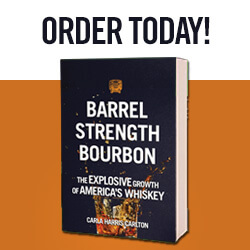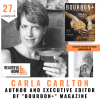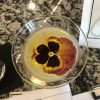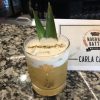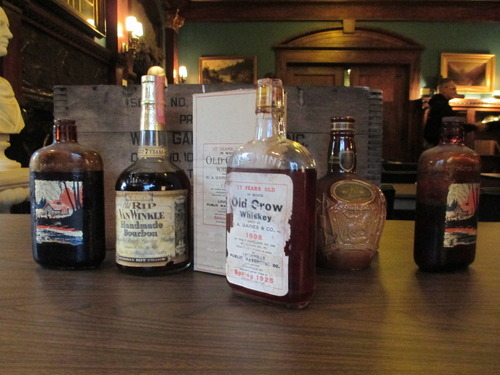
I know lots of people are still celebrating the Ravens, but I have another bird on my mind: Old Crow. More specifically, the 105-year-old bottle of Old Crow that I sampled last week at the Filson Historical Society. This terrific tasting led by bourbon historian Michael Veach also included a 1974 bottle of Old Rip Van Winkle and something called Broad Ripple bottled during Prohibition (and perhaps best left there, but more about that later).
We arrived at the Filson to find these wonderful dusty old bottles (donated as a fundraiser), along with new bottles of Angel’s Envy, which sponsored the event. Kyle Henderson, grandson of master distiller Lincoln Henderson, helped Mike pour (after a good-natured exchange in which Kyle countered Mike’s description of Angel’s Envy as “wine-flavored bourbon,” saying it’s “finished, not flavored”). It’s worth noting that Mike, below, opened all the bottles without breaking a single cork.
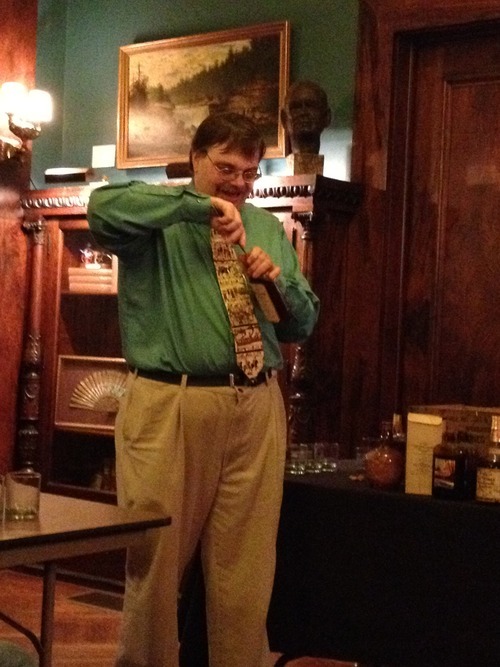
First up was the Old Crow, distilled in 1908 and bottled in bond (100 proof) in 1925. While we let our samples breathe, which Mike told us is always a good idea with old whiskeys, he gave us a history lesson. Old Crow is one of the oldest bourbon brands, founded by Scotsman James C. Crow in Woodford County, Ky., in the 1830s. While Crow did not possess the medical degree he claimed to have, he was one of the first people to apply scientific methods to distilling – and perhaps most important, he wrote everything down so that recipes could be replicated. In the 19th century, Old Crow was the standard for bourbon, quite a contrast to its current bottom-shelf status. (“Jim Beam should be put on trial for what they’ve done to Old Crow,” Mike declared.)
This bourbon was a nice dark color, with no cloudiness. It had a heady aroma of caramel, vanilla, spice and wood. It had a rather slippery mouth feel, with notes of cinnamon and caramel and a nice, long finish.
We were primed for our next sample: Broad Ripple, a bourbon bottled sometime in the early 1930s in Frankfort, Ky., for “medicinal purposes.” Let me say this: I would rather be sick. It had the odor of menthol and the taste of bad licorice mixed with, as someone put it, “the gauze the dentist puts in your mouth.” It’s possible that the bottle’s original contents were compromised at some point – “a lot can go wrong in 90 years,” noted attendee Julian Van Winkle III – but it’s just as likely that the producers had gone through all their good whiskey toward the end of Prohibition and just bottled whatever they could find, Mike said. “It tasted like crap, but who cared? It kept the brand alive, and most people were mixing it with other stuff anyway.”
By comparison, our third vintage bourbon smelled like candy. It likely would have anyway, though; assuming the 7-year-old, 107 proof Old Rip Van Winkle had been stored well and not oxidized, “this will probably be some of the best whiskey you’ve ever had in your life,” said Julian Van Winkle, whose family still owned a share of Stitzel-Weller when it was bottled there in 1974 or ’75. He was right: This wheated bourbon was robust, almost chewy, and bursting with flavor – caramel, vanilla, cherries, with oak and maybe a bit of apple at the end. “Oh my goodness, what a whiskey,” breathed the gentleman seated next to me.

They say that two out of three ain’t bad. In this case, it was pretty amazing.
Up next in the Bourbon Babe: News from Angel’s Envy.

